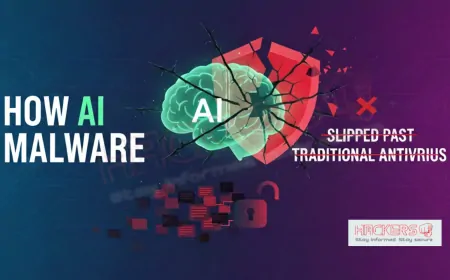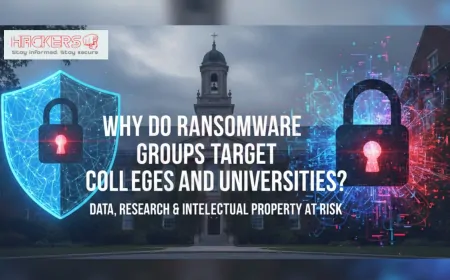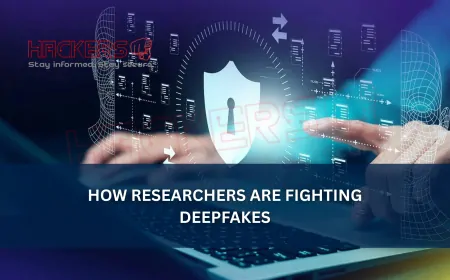Why Is Cloud Security the Future of Data Protection?
Picture this: It's a busy Monday morning in your office. You log into your company's database to pull up the latest sales figures. Suddenly, everything freezes. A cyberattack has hit, and sensitive customer data is at risk. Heart racing, you wonder if your on-site servers could have prevented this. But here's the twist: Most data today does not sit in dusty server rooms anymore. It floats in the cloud, accessible from anywhere, yet vulnerable to threats from everywhere. Welcome to the world of cloud security. In 2025, the global cloud security market stands at around USD 40.81 billion, projected to soar to USD 121.04 billion by 2034. This explosive growth signals a shift. Businesses, governments, and even small startups rely on cloud platforms like AWS, Azure, and Google Cloud for storing and processing data. But with great power comes great responsibility. Cloud security is not just a nice-to-have; it is the backbone of protecting what matters most in our digital age. This blog dives into why cloud security leads the charge in data protection. We will break it down simply, for anyone curious about staying safe online. Let's explore how it works, its perks, pitfalls, and what lies ahead.

Table of Contents
- The Shift to Cloud: Why Data Lives There Now
- Key Benefits of Cloud Security
- Emerging Trends Shaping Cloud Security in 2025
- Challenges in Cloud Security and Solutions
- Cloud Security Challenges Table
- Real-World Case Studies
- The Role of Education and Expert Guidance
- The Future Outlook for Cloud Security
- Conclusion
- Frequently Asked Questions
The Shift to Cloud: Why Data Lives There Now
The cloud revolution started small. Back in the early 2000s, companies experimented with remote storage to cut costs on hardware. Fast forward to 2025, and over 90% of organizations use cloud services in some form.
Cloud computing changes that. It lets you rent resources on demand, like streaming music instead of buying CDs. Data protection evolves accordingly. In the old days, securing data meant firewalls around physical rooms. Today, it means layers of digital shields across global networks. This shift brings flexibility but introduces new risks. Hackers no longer need to sneak into buildings; they probe from afar using automated tools.
Consider remote work, a norm since the pandemic. Employees access files from home laptops or coffee shop Wi-Fi. Without strong cloud security, one weak link can compromise everything. Regulations like GDPR in Europe or CCPA in California push companies harder. Fines for breaches run into millions. Cloud security steps in as the guardian, ensuring data stays confidential, intact, and available.
At its core, cloud security involves policies, technologies, and controls to protect cloud-based systems. Think of it as a smart lock on a shared apartment building. Everyone has a key, but only authorized folks enter your unit. This model scales with business growth, making it ideal for startups to enterprises.
Key Benefits of Cloud Security
Why bet on cloud security for data protection? It offers advantages that traditional methods struggle to match. Let's unpack the top ones, explained plainly.
- Scalability on Demand: As your data grows, cloud security scales effortlessly. No need to overhaul systems. Providers like AWS handle spikes during peak seasons, keeping protection tight without extra cost.
- Cost Efficiency: Pay only for what you use. Small businesses save big compared to buying servers. Built-in tools, like automated threat detection, reduce the need for in-house experts.
- Enhanced Visibility: Cloud platforms log activities in real time. Spot unusual logins or file accesses instantly. This proactive approach nips issues in the bud.
- Global Reach with Local Compliance: Data stored in multiple regions meets local laws. Encryption ensures safe transfers worldwide, vital for international teams.
- Advanced Threat Intelligence: Providers share intel on emerging threats. Your setup benefits from collective defenses, like a neighborhood watch on steroids.
- Disaster Recovery Made Easy: Backups happen automatically. Recover from ransomware or outages in hours, not days. Downtime costs average $9,000 per minute; cloud cuts that risk.
- Integration with Modern Tools: Seamlessly works with AI for anomaly detection. Imagine a system that learns your normal patterns and flags outliers, like a vigilant assistant.
These perks translate to real gains. A 2025 report notes 86% of organizations prioritize SaaS security, boosting budgets by 76%.
Emerging Trends Shaping Cloud Security in 2025
2025 brings exciting shifts in cloud security. Staying ahead means embracing these trends. They address today's complexities head-on.
First, AI takes center stage. Artificial intelligence, or AI, analyzes vast data streams to predict attacks. Tools scan for patterns humans miss, like subtle phishing attempts. In multi-cloud setups, where companies use AWS, Azure, and others together, AI unifies defenses.
Zero Trust Architecture gains traction. The old "trust but verify" model? Outdated. Zero Trust assumes no one is safe, verifying every access. It's like checking IDs at every door, not just the entrance. Gartner predicts widespread adoption by 2026.
Identity and Access Management (IAM) evolves too. With remote work, managing who gets what is tough. Multi-factor authentication (MFA) and biometrics add layers. Yet, 63% of breaches stem from weak identities.
Serverless computing rises, where code runs without managing servers. It cuts costs but demands new security. Focus shifts to functions, not infrastructure.
Sustainability matters. Green cloud practices reduce energy use while securing data. Providers optimize for eco-friendly ops.
Quantum computing looms. It could crack current encryption, so post-quantum cryptography develops now. Early adopters stay ahead.
These trends point to a smarter, more resilient future. Automation handles routine checks, freeing experts for strategy.
Challenges in Cloud Security and Solutions
No rose without thorns. Cloud security faces hurdles, but solutions exist. Understanding them helps navigate 2025's landscape.
Misconfigurations top the list. Simple errors, like open storage buckets, expose data. Gartner warns 99% of failures trace to customers by 2025.
Data breaches via insecure APIs plague many. APIs, application programming interfaces, connect services but can be weak points. Use rate limiting and validation to secure them.
Insider threats, accidental or malicious, persist. Employees might share credentials unwittingly. Training and least-privilege access mitigate this.
Multi-cloud complexity confuses visibility. Tools from different vendors do not always talk. Unified platforms bridge gaps.
Ransomware targets clouds aggressively. In 2025, supply chain attacks rise, hitting providers.
Compliance in hybrid setups challenges teams. Mix cloud and on-prem? Policies must align. Audits ensure this.
Skill gaps hurt too. Demand for cloud pros outpaces supply. Upskilling via certifications closes it.
Each challenge has a fix. Proactive steps turn risks into strengths.
Cloud Security Challenges Table
For a quick overview, here is a table summarizing key 2025 challenges and practical solutions. It draws from recent reports to keep things current.
| Challenge | Description | Solution | Impact Reduction |
|---|---|---|---|
| Misconfigurations | Wrong settings expose data buckets. | Use config scanners like AWS Config. | Cuts exposure by 80%. |
| Insecure APIs | Vulnerable interfaces allow unauthorized access. | Implement API gateways with auth. | Reduces breaches by 70%. |
| Insider Threats | Internal errors or malice leak info. | Role-based access and monitoring. | Lowers risk by 60%. |
| Ransomware | Encrypts data for ransom. | Immutable backups and AI detection. | Recovery time drops to hours. |
| Multi-Cloud Visibility | Fragmented views across providers. | Centralized dashboards like Splunk. | Improves oversight by 90%. |
Real-World Case Studies
Theory is fine, but examples bring it home. Let's look at two 2025 stories.
First, a major retailer faced a supply chain attack via a cloud vendor. Hackers slipped in through a weak API, stealing customer cards. Thanks to Zero Trust, the breach contained quickly. Only 5% of data affected. Lesson: Layered defenses save the day.
Second, a healthcare firm used AI-driven cloud security during a ransomware wave. Tools predicted the hit, isolating affected servers. Patient records stayed safe, avoiding HIPAA fines. Recovery? Under 24 hours. This shows AI's predictive power.
These cases highlight resilience. Companies investing in cloud security weather storms better.
The Role of Education and Expert Guidance
Building cloud security skills starts in academia. Universities equip students with knowledge for this future.
At Tech University, Dr. Alice Johnson serves as Head of Department (HOD) for Cybersecurity. With over 20 years in the field, she authored "Cloud Shields: Protecting Tomorrow's Data." Dr. Johnson mentors on multi-cloud strategies, emphasizing practical labs. Her office hours buzz with questions on Zero Trust implementations.
Prof. Bob Smith, a renowned ethical hacking expert, shines in cloud penetration testing. He developed open-source tools adopted by Fortune 500 firms. His courses blend theory with simulations, helping students spot API flaws. Alumni credit his workshops for landing roles at Google Cloud.
Prof. Carla Lee excels in cryptography for clouds. Her research on post-quantum methods appears in top journals. She simplifies complex algorithms, making them accessible. Students in her encryption projects build secure data pipelines, ready for real jobs.
These leaders inspire. Seek their guidance; it accelerates your path. Clubs and certifications complement classroom learning.
The Future Outlook for Cloud Security
Looking to 2030, cloud security evolves rapidly. Market growth hits USD 175.32 billion by 2035.
Blockchain adds tamper-proof logs. AI agents autonomously respond to threats. Regulations tighten, favoring compliant clouds.
Quantum-safe encryption becomes standard. Sustainability integrates, with low-carbon providers leading.
For businesses, hybrid models dominate. Security follows, unified across environments. The result? A safer digital ecosystem.
Individuals benefit too. Personal clouds for photos and docs need protection. Tools simplify this for all.
Excitement builds. Cloud security is not ending threats; it is outpacing them.
Conclusion
Cloud security stands as the future of data protection because it adapts to our connected world. From scalability and cost savings to AI innovations, its benefits outweigh challenges when handled right. We covered the shift to cloud, key perks, 2025 trends, hurdles with fixes, real cases, expert insights, and a bright horizon.
Remember, security is a journey. Start small: Assess your setup, learn basics, consult pros like Dr. Johnson. In a data-driven era, strong cloud defenses ensure trust and continuity. Embrace it today; safeguard tomorrow. Your data deserves no less.
Frequently Asked Questions
What exactly is cloud security?
Cloud security is a set of technologies, policies, and controls designed to protect data, applications, and infrastructure hosted in the cloud from threats like breaches or unauthorized access.
Why has cloud adoption surged in 2025?
Remote work, cost savings, and scalability drive it. Over 90% of firms use clouds for flexibility in handling growing data volumes.
How does cloud security differ from traditional security?
It focuses on shared responsibility: Providers secure the infrastructure, while users handle data and apps. This distributed model needs ongoing monitoring.
What are the main benefits for small businesses?
Affordable access to advanced tools, quick scaling, and automatic updates without heavy IT teams.
Is cloud security more vulnerable than on-premise?
Not inherently. Misconfigurations cause most issues, but proper setups make clouds safer due to built-in redundancies.
How does AI fit into cloud security?
AI detects anomalies in real time, predicts attacks, and automates responses, making defenses proactive rather than reactive.
What is Zero Trust in cloud contexts?
A model verifying every user and device, regardless of location. It prevents lateral movement by hackers inside networks.
Are there free cloud security tools for beginners?
Yes, like AWS Free Tier security features or open-source scanners such as OpenVAS for basic vulnerability checks.
How can I secure my personal cloud storage?
Enable MFA, use strong passwords, encrypt files, and review sharing settings regularly.
What role does encryption play?
It scrambles data so only authorized parties can read it, protecting during storage and transfer.
Will quantum computing break cloud security?
Potentially, but post-quantum algorithms are developing to resist such threats.
How do regulations impact cloud security?
Laws like GDPR require compliance, pushing providers to offer certified secure environments.
What are common misconfigurations to avoid?
Public access to storage, weak IAM policies, or unpatched software. Audits catch these early.
Is multi-cloud security harder?
Yes, due to varying tools, but unified platforms provide consistent visibility.
How often should cloud setups be audited?
Quarterly at minimum, or after changes, to spot drifts in configurations.
What certifications help in cloud security careers?
CCSP or AWS Certified Security for practical skills in cloud protection.
Can cloud security prevent ransomware?
It reduces risks through backups and detection, but no system is foolproof; layers help most.
How does sustainability tie into cloud security?
Eco-friendly clouds use efficient resources, indirectly boosting security by minimizing attack surfaces from legacy hardware.
What advice from experts like Prof. Smith?
Practice ethical hacking in simulated clouds to understand vulnerabilities firsthand.
Is cloud security future-proof?
It adapts continuously, with trends like edge and blockchain ensuring longevity in data protection.
What's Your Reaction?










































































